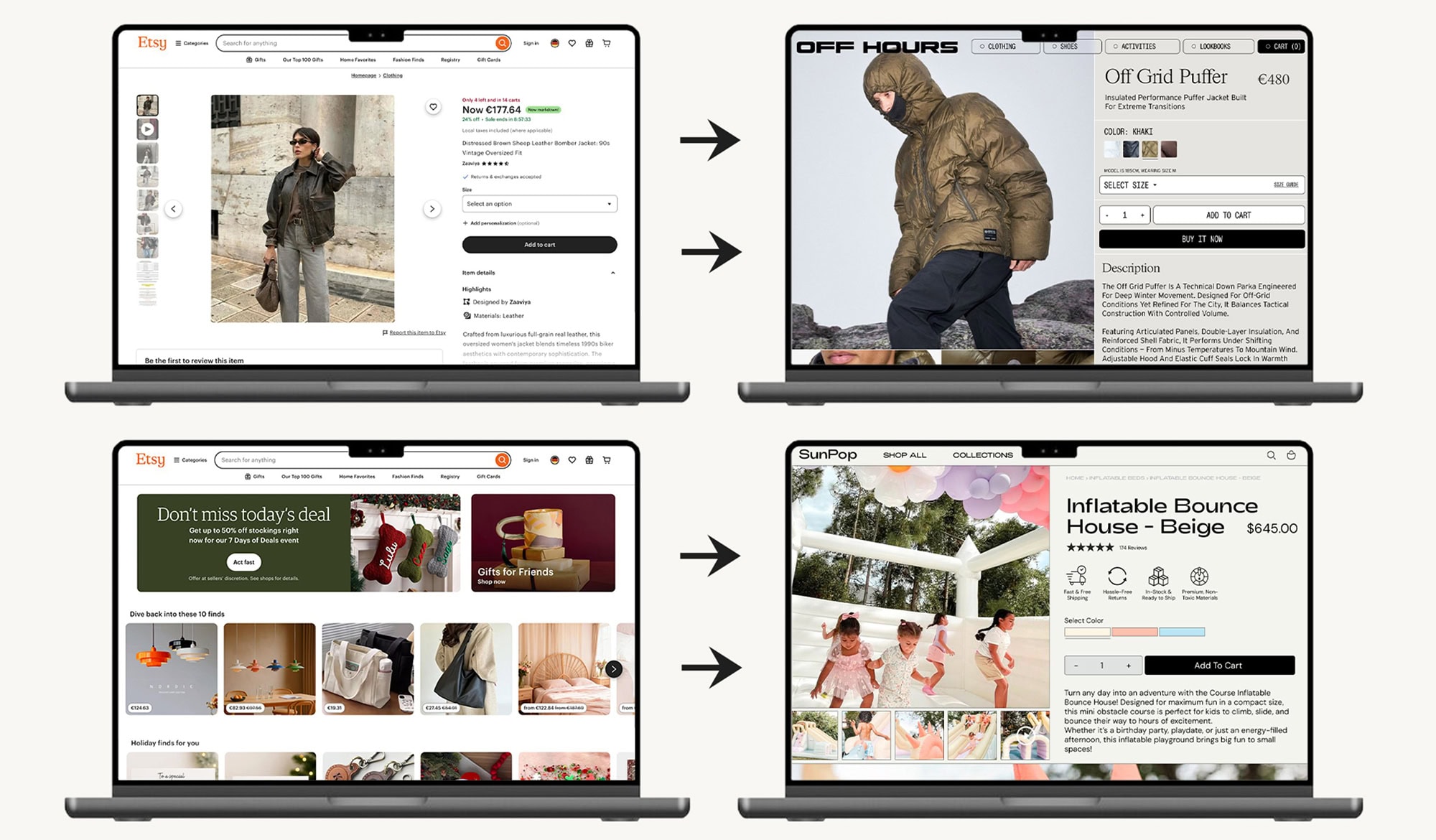In the rapidly evolving landscape of e-commerce, the perceived threat of competition often overshadows its true value. Many entrepreneurs view a crowded market as "saturated" and impenetrable, leading to hesitation or a focus on unsustainable price wars.
This guide reframes that perspective: the presence of competition is the single most important signal of a viable, profitable market. It provides a detailed, ethical, zero-cost workflow for turning competitor data into a unique, differentiated business strategy.
Philosophy: Compete to Create, Not to Conquer.
Part I: The Meaning of Competition - A Sign of Life, Not Saturation
1. Competition as Validation: Why a Crowded Market is Your Best Friend
- Competition is often misinterpreted as a barrier to entry, but it is actually a signal of market validation and existing customer demand.
- A category with numerous successful players shows that customers are actively spending to solve a problem or fulfill a desire.
- Markets with no competition often indicate they are non-existent, too niche, or not ready for commercialization.
Reframing "Saturated": The Myth of the Impenetrable Category
- "Saturated" suggests a market is full and impenetrable—but no category is truly impenetrable.
- Markets evolve constantly due to consumer tastes, technology, and business cycles.
Case Study: Apparel and Skincare
- Apparel:
- Giants like Zara and H&M dominate fast fashion.
- DTC brands like Everlane (ethical sourcing) and Gymshark (fitness-focused) achieved billion-dollar valuations.
- Success came from differentiation and niche focus, not just price or selection.
- Skincare:
- Established brands like L'Oréal and Estée Lauder exist, yet The Ordinary (clinical ingredients) and Drunk Elephant (clean branding) succeeded by targeting underserved, ingredient-savvy consumers.
- Insight: The constant emergence of new brands alongside the failure of others illustrates the Natural Cycle of Business—competition drives market evolution.
2. Identifying Your Competitive Landscape
A sophisticated understanding of competition requires categorizing rivals by the nature of their threat.
- Direct Competitors:
- Sell the same product or service to the same audience (e.g., two brands selling organic cotton t-shirts).
- Focus: Pricing, product features, and primary marketing channels.
- Indirect Competitors:
- Solve the same problem with a different product (e.g., meal kits vs. frozen dinners).
- Focus: Underlying customer need and unique value proposition.
- Substitute Competitors:
- Products customers may choose instead of yours (e.g., repairing instead of replacing an item).
- Focus: Customer cost-benefit reasoning when deciding not to purchase.
The "Zero-Sum" Fallacy
- The belief that one company’s gain equals another’s loss is false.
- E-commerce constantly expands through technology, logistics, and marketing.
- Strategy: Focus on differentiation and creating new value rather than fighting for existing customers.
Part II: Ethical and Effective Competitor Research
3. The Research Imperative: What to Look For
Competitor research is intelligence gathering—not copying. It identifies patterns of success and failure to minimize risk and maximize differentiation.
- Product Validation:
- Confirms which products, features, or bundles resonate with customers.
- Insight: Reduces risk of launching unproven products and prioritizes features.
- Marketing Hooks and Angles:
- Identifies effective ad copy, creative ideas, and emotional triggers.
- Insight: Provides proven frameworks for communicating value.
- Content Strategy:
- Examines blogs, social media, and educational content.
- Insight: Reveals audience questions and guides content creation.
- Pricing and Offers:
- Shows market price ranges and discount strategies.
- Insight: Helps position products competitively and plan profitable promotions.
4. The Golden Rule: Research, Never Copy
- Competitive analysis is observation; imitation is unethical and risky.
- Copying consequences: Weak brand identity, vulnerability to price wars, and legal risks.
- Goal: Identify gaps and create unique value, not replicate competitors.
Part III: The Zero-Cost, High-Value Competitor Research Workflow
5. Step-by-Step: The Low-Budget Competitor Deep Dive
Step 1: Social Media Ad Spy (Facebook Ads Library)
- Free tool to see all active ads on Facebook, Instagram, Messenger, and Audience Network.
- Actions:
- Search by competitor to see campaigns, dates, and platforms.
- Search by keyword/topic to discover indirect competitors.
- Analyze top-performing ads: Hook, CTA, and Ad Copy Length.
- Identify offers via landing pages (price, promotions, bundles).
Step 2: Customer Review Audit (Amazon, Trustpilot, Competitor Websites)
- Reviews reveal what customers love and hate.
- Actions:
- Filter 1-star reviews to identify product gaps and pain points.
- Filter 5-star reviews to identify strengths and key benefits.
- Analyze Q&A sections for customer confusion or gaps.
Framework: Jobs to Be Done (JTBD) — Customers "hire" products to do a specific job, not just buy an item.
Step 3: SEO and Content Snapshot
- Reveals competitor strategies for organic traffic and authority.
- Actions:
- Identify top-ranking content using Google search operators (
site:competitor.com intitle:"keyword"). - Find keyword gaps with Ubersuggest or Google Keyword Planner.
- Track brand interest and trends via Google Trends.
- Analyze website structure and category prioritization.
- Identify top-ranking content using Google search operators (
Step 4: Email & Funnel Mapping ("Secret Shopper" Method)
- Understand post-purchase and retention strategies.
- Actions:
- Sign up for newsletters to analyze cadence, content, and offers.
- Test abandoned cart sequences for follow-up emails and discounts.
- Purchase low-cost items to evaluate shipping, packaging, inserts, and returns.
6. Leveraging AI for Creative Competitor Analysis
- AI accelerates pattern recognition and idea generation.
- Feed AI raw data (ads, reviews, product descriptions) to generate unique strategies.
AI Prompt Examples:
- Identifying Gaps from Reviews:
- Analyze reviews to find complaints and suggest product features.
- Example: Broken zippers → Use waterproof YKK zippers → USP: "Guaranteed for Life Zippers."
- Generating Unique Ad Angles:
- Input competitor ad copy; AI generates original hooks.
- Example: "Expensive coffee?" → "Get perfect espresso in 30 seconds flat."
- Deconstructing and Countering Value Proposition:
- Break down competitor VP and create superior alternatives.
- Example: "Affordable, stylish glasses delivered in 7 days" → "Indestructible eyewear with lifetime guarantee."
Part IV: Actionable Differentiation Strategies
7. Strategic Pathways to Differentiation
Insights from competitor research can be transformed into four pathways for differentiation:
Pathway 1: Product-Centric Differentiation
- Address review gaps:
- Poor durability → Superior quality and guarantee (e.g., Lifetime Warranty)
- Lack of customization → Hyper-personalization
- Missing features → Feature stacking
Pathway 2: Marketing and Messaging Differentiation
- Address ad/content gaps:
- Homogenous messaging → Emotional or value-based hooks
- Poor educational content → Authority building and guides
- Unaddressed niche → Vertical niche focus
Pathway 3: Experience and Service Differentiation
- Address funnel gaps:
- Slow/expensive shipping → Frictionless logistics
- Generic post-purchase communication → Hyper-engaged retention
- Poor packaging/unboxing → Premium unboxing experience
8. The Differentiation Matrix: Turning Gaps into Your Value Proposition
- Map competitor weaknesses to your strengths and create new value propositions.
- Examples:
- Product breaks → Aerospace-grade materials, lifetime warranty → "The only [Product] built to last a lifetime."
- Ads focus on price → Ethical sourcing, farmer story → "Ethically sourced [Product]: Feel good about what you buy."
- Confusing returns → 365-day free returns → "Try it risk-free. If you don't love it, we'll take it back."
Conclusion: Compete to Create, Not to Conquer
- View competition as a roadmap, not an obstacle.
- Use competitor insights to innovate and differentiate.
- Create better products, clearer messaging, and more valuable experiences.
- Focus on gaps, embrace market cycles, and achieve a sustainable competitive edge.








.jpg)

